Writing Workshop Mini-Lessons Day 3: Creating Interesting Characters
Day 3: Creating Interesting Characters
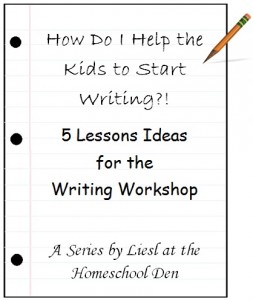
Here are some of our first mini-lesson topics. I used mentor texts and picked them apart to help the kids see some of the elements that make for good writing.
In this series I’ll go into more detail on each one:
- What makes a good book or story?
- Make your story come alive with details and description.
- Creating Interesting Characters
- Story Openings: Set the mood or feeling of your story
- Gathering story ideas from your own life
- Alliteration and more
- Adding Details Exercise Don’t miss this one, the kids LOVED this activity!!
- Writing Workshop: Conflict in Literature (Man vs. Man, Man vs. Self, etc)
- Writing Workshop Discussion Questions
- Writing Workshop Mini-Lesson: Rules for Writing and the Story Writing Process
- Writing Workshop – Depth and Complexity Icon Activity
You can use these lessons in any order.
Day 3: Creating Interesting Characters
I have found that reading a children’s book has been a great way to start our writing workshop because it centers us, has all the elements of good writing and gives us something tangible to talk about. The kids (and I) have learned writing skills from some of the best authors around! We read a lot of long novels at other times, but reading a book that takes less than five minutes from start-to-finish allows us to look at some of the elements of good writing — the way suspense builds towards the climax or the development of characters. If we have read a longer book together, we often bring those into the discussion as well (The Chronicles of Narnia, Because of Winn Dixie, Island of the Blue Dolphin). But, if I want to focus the discussion and pick apart a text closely children’s book have been invaluable.
After I read a book (or book selection) aloud, we talk briefly about one writing element. My hope is that the mentor text will motivate the kids to write… they might be inspired by the ideas in the text, structures or skills we’ve talked about.
I loved this description of the mini-lesson: “Each day you are planting seeds–seeds that will grow into a lifelong understanding of quality writing. Instead of mentioning a skill once, or for one week, you will return to these same concepts” at other times in the year.
Together the kids and I are on a journey to discover what makes good writing?
In the lesson below we looked a bit more closely at how authors create memorable characters.
Discussion with the Kids:
What is a character? a hero? a villain? protagonist? supporting characters?
I made sure the kids knew what those terms meant. I said that authors spend a lot of time trying to make the characters seem real and interesting.
The protagonist is the character with the starring role in the book or story. In most novels, the protagonist is on a journey to get what he or she wants more than anything else in the world — whether it’s fame, revenge, adventure, freedom…
Reading Together:
I grabbed a very short book we happened to have called David and Goliath. The kids were easily able to identify the hero (David), the villain (Goliath), and the supporting characters. [You could use whatever book you have around… or talk about characters such as the White Witch and Aslan in the Lion, the Witch and the Wardrobe
What memorable villains do you love to hate? [the Big Bad Wolf, Voldemort and Severus Snape, Captain Hook, Rumpelstiltskin, the Wicked Witch of the West, Darth Vader, Cruella de Vil]
What does the protagonist hope to achieve in this story?
In this book, the hero and villain were very clear cut, but in more sophisticated books the characters are more complicated. Maybe, there’s a villain who sees a puppy drowning in a lake and saves it. That makes the character more 3-dimensional and interesting.
When an author creates a character it is important he/she creates a picture in our mind. She describes what they look like, what clothes they are wearing and become very real to us. We often start to have feelings about this character.
What is a character from a book you’ve read that you really love? Can you describe them? How do you feel about them? Do you know what they wear? What they like to eat? If you were to invite that character to lunch, would it be easy to talk to them?
If an author has done a good job of creating a character, the character will seem almost real. Often the reader will feel like they “know” them well.
Independent Writing:
When you go off to write today, you might think about the characters you want to develop. Will your characters have flaws? strengths? good traits? Try to create good, clear descriptions of the characters in your stories
The kids know that they can write whatever they want. As I reach for the timer, I sometimes ask them… What are you going to write about?… Are you still working on your story about the phoenix?
We set the timer for 10 minutes and went off to write. When we came back together, I asked if any of them wanted to share their stories.
Final Product: That day we were sitting outside. The kids sat back quietly to think. The sound of the cicadas was extremely loud and not surprisingly the kids wrote stories about a cicada! That’s perfectly okay too… The goal of these mini-lessons is not to act as writing prompts, but to help build a foundation and provide them with tools to improve their writing.
Follow Up:
I try to keep our mini-lessons to 10 minutes or less, but another day I might do another lesson showing how the description of the character often goes hand in hand with a description of the setting.
If I were to think of my Mom, I would think of her sitting with a pile of papers to grade in the brown swivel chair in our living room.
Think of someone you know. Where would you picture them?
Now think about a character from a book you’ve read. Can you visualize a place where they would be?
Writing MiniLessons Day 3– Creating Interesting Characters
Do you want to learn more about starting your own Homeschool Writing Workshop? Here are some related posts:
- Creating a Homeschool Writing Workshop – Post #1 — How/Why we needed a change in our writing program
- Creating a Homeschool Writing Workshop – Post #2: Creating a Writing Workshop Area and Materials to Have on Hand
- Creating a Writing Workshop Post #3: This post is about Mini-Lessons during writing time, mentor texts and includes reviews of 8 or 9 writing books that you might find helpful.
- Writing Resource Pack: This is a post about the 30-page pack I made for our writing workshop. Reference pages on the 6 +1 Wri ting Traits, Mini-Lessons, the types of writing, creating a powerful beginning, techniques for ending a story/paper, and so forth. (These writing resources are free to download.)
- Writing Workshop: Dr. Seuss Style: The kids and I had fun writing in the style of Dr. Seuss!
- Biography Research Paper Resource Pack
- Practical Pointers for Working with a Reluctant Writer (or any Writer)
- Writing Activity to Spark Kids’ Imagination!
- 40 Journal Writing Prompts (Free Printable)
- Animal Portfolio Project: writing, art and geography activities that go with any animals… With many activities to choose from. Writing activities include both fiction and non-fiction suggestions such as
- Write a speech or a letter to the president on why your animal needs protection in the wild.
- Menu: Create a humorous menu at a restaurant where your animals would like to eat.
- WWII Portfolio Project
- Writing Workshop Rules! Why the Writing Workshop continues to work so well in our homeschool.
Mini-Lessons to Use in a Writing Workshop:
- What makes a good book or story?
- Make your story come alive with details and description.
- Creating Interesting Characters
- Story Openings: Set the mood or feeling of your story
- Gathering story ideas from your own life
- Alliteration and more
- MiniLesson – Describing in Detai- – Additing Details Exercise – Fun Activity!(Don’t miss this one, the kids LOVED this activity!!)
- Writing Workshop: Conflict in Literature (Man vs. Man, Man vs. Self, etc)
- Writing Workshop Mini-Lesson: Rules for Writing and the Story Writing Process
- Writing Workshop Mini-Lesson: Rules for Writing and the Story Writing Process — Have your kids read the Plot Chicken? We started our Writing Workshop this year off with this book. What a great buk, buk!! In fact, I liked it so much that I created a chicken writing rules printable to go along with the book!
See you again soon here or Homeschool Den Facebook page. Don’t forget to Subscribe to our Homeschool Den Newsletter! ~Liesl
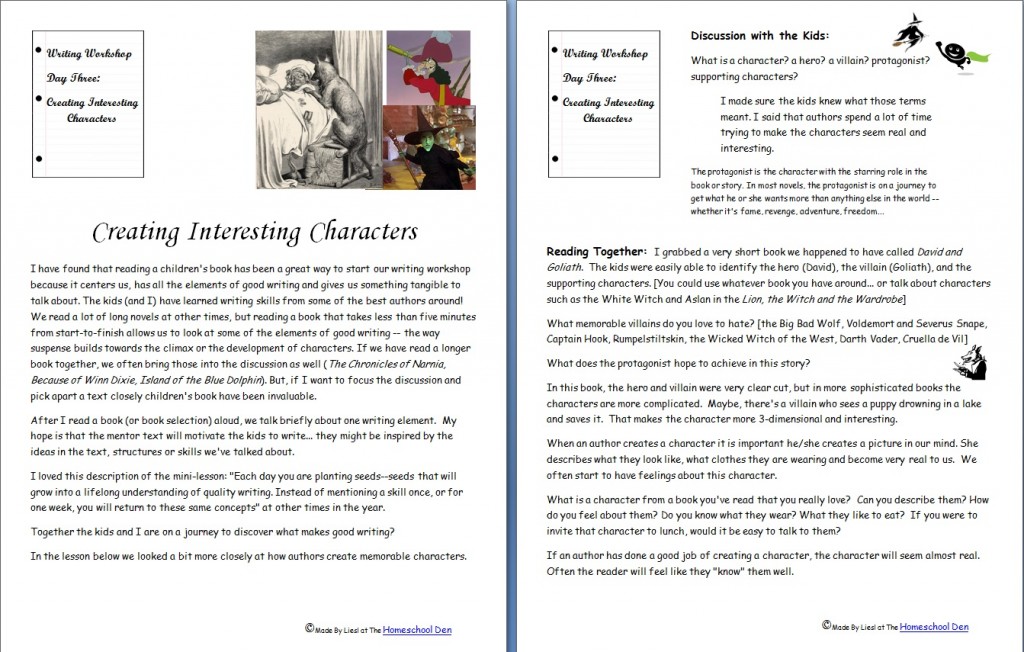


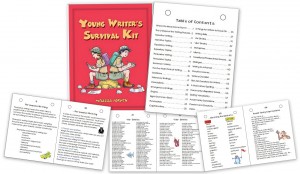
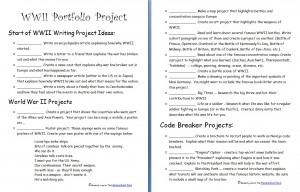
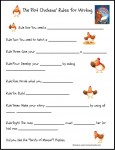






















































16 Responses
[…] Creating Interesting Characters […]
[…] Creating Interesting Characters […]
[…] Creating Interesting Characters […]
[…] Creating Interesting Characters […]
[…] Creating Interesting Characters […]
[…] Creating Interesting Characters […]
[…] Creating Interesting Characters […]
[…] Creating Interesting Characters […]
[…] Creating Interesting Characters […]
[…] Creating Interesting Characters […]
[…] Creating Interesting Characters […]
[…] Creating Interesting Characters […]
[…] Creating Interesting Characters […]
[…] Creating Interesting Characters […]
[…] Creating Interesting Characters […]
[…] Creating Interesting Characters […]